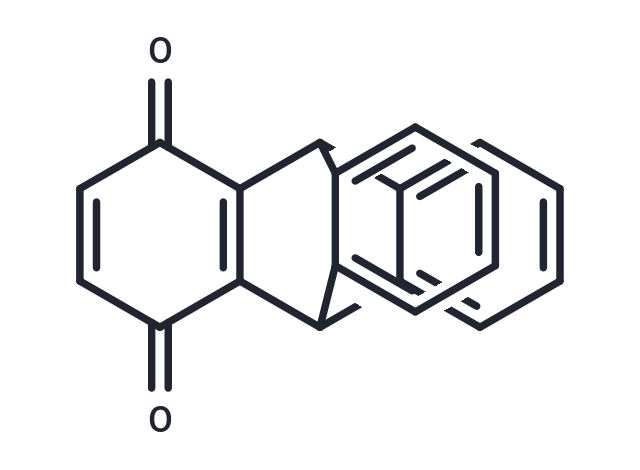Shopping Cart
- Remove All
 Your shopping cart is currently empty
Your shopping cart is currently empty

INCA-6 (Triptycene-1,4-quinone) is a cell-permeable NFAT inhibitor that disrupts CN-NFAT signaling by targeting the NFAT(P) substrate at the calcineurin (CN) phosphatase site.

| Pack Size | Price | Availability | Quantity |
|---|---|---|---|
| 5 mg | $30 | In Stock | |
| 10 mg | $51 | In Stock | |
| 25 mg | $98 | In Stock | |
| 100 mg | $339 | In Stock | |
| 500 mg | $738 | In Stock |
| Description | INCA-6 (Triptycene-1,4-quinone) is a cell-permeable NFAT inhibitor that disrupts CN-NFAT signaling by targeting the NFAT(P) substrate at the calcineurin (CN) phosphatase site. |
| In vitro | In human retinal microvascular endothelial cells, INCA-6 (1.0, 2.5 μM) significantly decreases VEGF and serum-induced proliferation without affecting baseline proliferation[1]. In 3-Hz cells, INCA-6 (5 μM) prevents transient outward K+ current downregulation[2]. INCA-6 (10 μM) significantly inhibits ATP-induced CXCL2 expression in rat primary microglia and BV-2 cells[3]. INCA-6 (5 μM) protein expression and reduces SERCA2 transcript levels with and without thapsigargin[4]. |
| In vivo | INCA-6 (2.5, 5.0, and 25.0 μM; intravitreal) significantly reduces pathologic neovascularization in oxygen-induced retinopathy and decreases the severity of OIR in a dose dependent manner[1]. |
| Alias | Triptycene-1,4-quinone |
| Molecular Weight | 284.31 |
| Formula | C20H12O2 |
| Cas No. | 3519-82-2 |
| Smiles | O=C1C=CC(=O)C2=C1C1c3ccccc3C2c2ccccc12 |
| Relative Density. | 1.38g/cm3 |
| Storage | Powder: -20°C for 3 years | In solvent: -80°C for 1 year | Shipping with blue ice. | ||||||||||||||||||||
| Solubility Information | DMSO: 2.84 mg/mL (10 mM), Sonication is recommended. | ||||||||||||||||||||
Solution Preparation Table | |||||||||||||||||||||
DMSO
| |||||||||||||||||||||

Copyright © 2015-2025 TargetMol Chemicals Inc. All Rights Reserved.